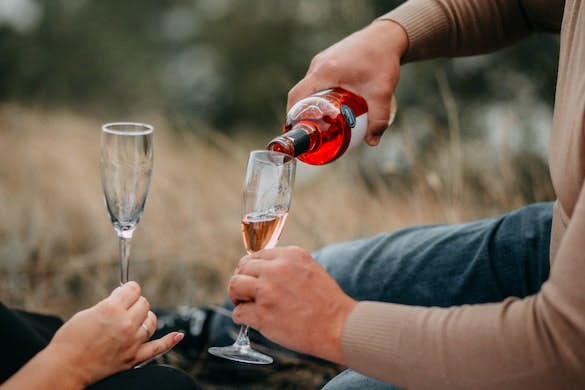Context Is Key: Secrets of a Fall Favorite, Rosé, Both Still and Sparkling
Contrary to popular belief, the color of a rosé says absolutely nothing about its level of residual sugar, or sweetness.

There is nothing like drinking rosé in October to retain the vibe of summer just a little while longer. Actually, one of the best things about good quality rosé is that it actually improves in the fall, with a few more months of bottle aging. That certainly held true for the two wines I chose for last month’s Context is Key.
Both wines, the Moussamousettes and Lamoresca, showed exactly how I thought they would: youthful, fresh, easy to drink, with bright acidity and a little bit of fruit but a lot more mineral. They paired well with my complex dinner, but were simple in a comforting way. They were also great representative examples of the choices winemakers make when crafting different styles of wines.
Both still and sparkling rosé usually start out being made the same way. Generally, high-quality versions, like these, are treated like white wines, where higher levels of acidity are required for structure and freshness. Red grapes are farmed with the intention of making rosé (rather than red wine), then the juice is pressed off the skins, either immediately or after just a few hours, to avoid picking up the color found there.
Alternatively, the saignèe method is a byproduct of red wine production where a winemaker wants to concentrate the color of the finished wine by bleeding off some of the juice at pressing. While some of these end up being delicious, they are often too low in acidity to have that signature refreshing quality sought out by most rosé drinkers. Some countries also allow white grapes to be blended with a little bit of red for a pink wine.
Contrary to popular belief, the color of a rosé says absolutely nothing about its level of residual sugar, or sweetness. The color is dependent on the shade of the grape variety being pressed and the amount of time the skins, where the color is, stays in contact with the juice.
The sugar is found inside a grape berry and is fermented into alcohol. If winemakers choose to halt fermentation and leave some of that grape sugar in the final wine, it will be sweet. Or, they can add sugar back in, in the form of unfermented grape juice. Finally, some lower acid, more fruit-centric styles of rosé can taste sweet, because of their lack of freshness.
Color is a pressing and macerating decision. Sugar is a fermenting decision. Any correlation is to be found in the marketing department, not the winery. The Lamoresca was a great example of this, deeper in hue than the prevalent Provençal-style rosés, super dry, with barely any fruit showing.
Now, most sparkling wine is made by taking that still wine, adding more yeast and sugar, and trapping the subsequent carbon dioxide to create bubbles. Not the one I chose, though, which is a petillant natural, or pet-nat for short. These are made with the ancestral method, originally bubbly by mistake, and now repopularized and produced in a more carefully planned out way.
Grape juice partially ferments and is then bottled, where the remaining sugar finishes fermenting and the bubbles are trapped. The results are often smaller, softer bubbles and occasionally some leftover sweetness.
For rosés destined to be bubbly, grape selection is even more important than for wines. Bubbles are little magnifying glasses, so whatever is in the base needs to be as perfect as possible. High-quality sparklers are, or should be, made from grapes with higher levels of acidity than still wines. This gives them a refreshing expression and a balanced structure. Too little acid and they can taste flat, or cloyingly sweet (think of the 12 tablespoons of sugar in a can of Coca-Cola; you don’t taste it thanks to the soaring amount of phosphoric acid used to balance it out).
Sugar ripeness needs to be kept in check, if the subsequent alcohol is too high, the wine will smell of booze and taste “hot,” burning as it goes down. The same idea goes for tannin, which can feel overwhelmingly harsh and is why most sparkling wine is white, or rosé, with the rare red exceptions.
There is a misconception that grapes harvested for sparkling wines (and rosé) are picked unripe. If that were true, then the final wines would end up with bitter, green, unripe flavors, not what is expected of quality wines.
To achieve that balance of physiologically ripe fruit, low sugar, and high acidity, site selection is paramount. One needs a locale where the flavors, or polyphenols, in the skins are able to develop fully (adequate heat and sunshine), while the acidity remains high (low average or nighttime temperatures) in relation to the sugar levels accumulating in the juice (photosynthesis needs sun to function, but not too much).
Traditionally, the best sparkling wines were made in northern climates, like Champagne, and now that’s true even farther north, like in England. Other ways a vigneron can farm sparkling wine grapes is by staking out cooler sites in warmer places, like the high-altitude vineyards in Catalonia (birthplace of Cava), or the fog-covered vineyards of Anderson Valley (where Roederer has its California wineries), or south-facing sites in the southern hemisphere (opposite in the northern) like Yarra Valley, Australia, for some exceptional bubs from down under.
Moussamousettes is made by Domaine Moss and comes from the traditional, northern, cool-climate region of Loire Valley. The Mosses are known for making great rosé and sparkling wines, and they were one of the first to hit big with their Moussamousettes pet-nat, before the trend really kicked in. (It was quite possibly the first pet-nat I ever drank.)
This vintage, 2021, actually did have just a touch of greenness, due to it being an abnormally cold vintage, but the flavor didn’t overwhelm and neither I nor my tasters minded it at all. Overall, they nailed the rosé pet-nat style: simple in flavor, a touch salty, with almost no fruit flavors, just a thought of strawberries, with super tiny, prickly bubbles, thanks to well-measured and -timed bottling, and structurally balanced with a very fresh and lively palate, low alcohol, and a dry finish.
Lamoresca’s Rosato was more of a surprise in how balanced it was. It comes from a very warm Mediterranean climate, in southern Sicily. They managed to get fully ripe fruit and a wine at only 11.5 percent alcohol from a combination of factors, such as elevation of about 1,350 feet and winds helping to cool things down. Indigenous grape varieties that evolved in the climate, Frappato, Nero d’Avola, are grown specifically because they are capable of that ripe flavor, low sugar, high acid balance.
Tasting it, there was more going on with this wine. It showed its place: blood orange, strawberry, flint and stones, plus lower acidity than the Loire Valley pet-nat, as was expected. The riper fruit meant more concentration, and the few extra months in the bottle allowed all these facets to develop and then coalesce. It paired perfectly with our dinner — lamb with anchovies and rosemary, harissa oven fries, pan roasted fennel and Italian stuffed artichokes — not overpowering but complementing each dish. It sent us right to summers on the Med.
Next month, we will discuss two of Italy’s greatest red grapes, perfect with fall food: Sangiovese and Nebbiolo.
Rocca di Castagnoli, Chianti Classico, 2019
Giafranco Alessandria, Langhe Nebbiolo, 2020
As always, don’t worry about finding the same wines. But I do encourage you to pick examples that have no new oak, which can mar the flavor of the fruit.

